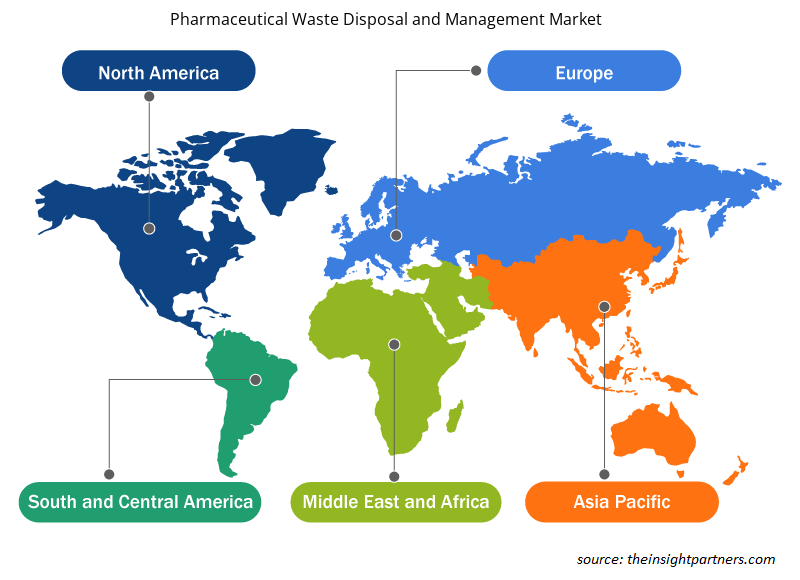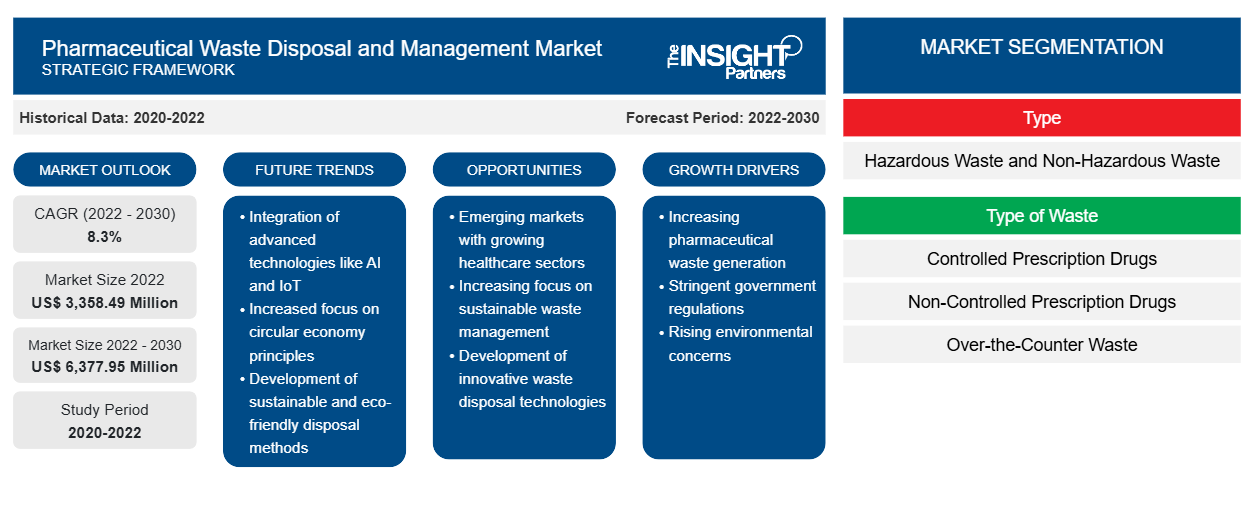[研究报告] 制药废物处理和管理市场预计将从 2022 年的 33.5849 亿美元增长到 2030 年的 63.7795 亿美元;预计 2022 年至 2030 年的复合年增长率为 8.3%。CAGR of 8.3% from 2022 to 2030.
市场洞察和分析师观点:
医药废物包括未使用的产品或已过期的药物。根据其化学成分,这些废物可分为危险废物或非危险废物。将药物归类为医药废物还取决于它是否对公众健康或环境构成风险。除了由于前面提到的原因而剩余的处方药外,医药废物还包括制造过程中的剩余材料和非处方药。推动医药废物处理和管理市场增长的关键因素包括政府加大力度推动妥善处理医疗废物,以及提高人们对医药废物的认识。然而,与医药废物处理相关的高成本阻碍了市场的增长。
增长动力和限制因素:
医院、诊所和其他医疗机构会产生大量废物。近年来,政府在促进医疗废物的适当处置方面做出了巨大努力,因为不当的管理和处置对人类健康和环境构成了日益严重的风险。医疗设施的扩张和医疗废物产量的激增是导致医疗废物处置和管理产品和服务需求激增的两个主要因素。一些政府已采取措施控制与医疗废物相关的问题,颁布法律和政策,保证医疗废物的安全适当处置。医疗废物通常需要妥善处置,并根据这些规则进行包装、运输、处理和分类。在美国,疾病控制和预防中心 (CDC)、职业安全与健康管理局 (OSHA) 和美国食品药品管理局 (FDA) 等机构都制定了有关医疗废物的法规。第 49 CFR 是一项联邦法规,重点关注医疗废物法规、收集和处置过程,而 49 CFR 173.197 则侧重于受监管的医疗废物。 CFR is a federal regulation focused on medical waste regulations, collection, and disposal processes and 49 CFR 173.197 focuses on regulated medical waste.
另一方面,整个处置过程的高成本是制药废物处置和管理企业的主要担忧,影响到药品供应商、医疗机构和废物管理服务提供商。处置过程的每个步骤都涉及高成本,包括适当的废物包装、分类、运输、处理、文书工作和合规性。此外,处置制药废物的高成本是由于实施专门的协议、遵守法规以及对可持续和合乎道德的废物管理技术的要求。
定制此报告以满足您的需求
您可以免费定制任何报告,包括本报告的部分内容、国家级分析、Excel 数据包,以及为初创企业和大学提供优惠和折扣
- 获取此报告的关键市场趋势。这个免费样品将包括数据分析,从市场趋势到估计和预测。
报告细分和范围:
全球制药废物处理和管理市场根据类型、废物类型和应用进行细分。根据类型,制药废物处理和管理市场分为危险废物和非危险废物。根据废物类型,制药废物处理和管理市场分为受控处方药、非受控处方药和非处方废物。根据应用,市场细分为医疗机构、药房、制药和生物技术公司等。根据地理位置,制药废物处理和管理市场分为北美(美国、加拿大和墨西哥)、欧洲(德国、法国、意大利、英国、俄罗斯和欧洲其他地区)、亚太地区(澳大利亚、中国、日本、印度、韩国和亚太地区其他地区)、中东和非洲(南非、沙特阿拉伯、阿联酋和中东和非洲其他地区)以及南美洲和中美洲(巴西、阿根廷和南美洲和中美洲其他地区)。
节段分析:
医药废物处理和管理市场按类型分为危险废物和非危险废物。非危险废物部分在 2022 年占据了更大的市场份额。然而,预计危险废物部分在 2022-2030 年期间的复合年增长率会更高。
根据废物类型,医药废物处理和管理市场分为受控处方药、非受控处方药和非处方废物。非受控处方药部分在 2022 年占据了最大的市场份额。预计 2022 年至 2030 年期间的复合年增长率最高。
根据应用,制药废物处理和管理市场分为医疗机构、药房、制药和生物技术公司等。2022 年,制药和生物技术公司占据了最大的市场份额。预计该部门在 2022-2030 年期间的复合年增长率最高。 CAGR during 2022–2030.
区域分析:
根据地理位置,全球制药废物处理和管理市场分为五个主要区域——北美、欧洲、亚太、南美和中美以及中东和非洲。2022 年,北美占据了最大的市场份额。北美市场反映了由严格的法规、先进的废物管理技术和对环境管理的承诺所驱动的复杂格局。美国《资源保护和回收法案》(RCRA)和《加拿大环境保护法案》(CEPA)等立法推出了安全处理和处置医药废物的强制性协议,随后监测对这些协议的遵守情况,这有利于医药废物处理和管理市场的增长。RCRA) and the Canadian Environmental Protection Act (CEPA) roll out the mandatory protocols for the safe handling and disposal of pharmaceutical waste, followed by monitoring adherence to the same, which benefits the pharmaceutical waste disposal and management market growth.
行业发展和未来机遇:
以下列出了全球医药废物处理和管理市场的主要参与者采取的各种举措:
- 2023 年 11 月,住友制药株式会社同意与欧力士生态服务株式会社合作,作为回收住友制药生产的处方药包装过程中产生的泡罩包装废弃物的计划的一部分。
- 2023 年 5 月,欧力士环保服务成为日本第一家获得工业废物处理许可证的公司,用于剥离泡罩包装废物和其他材料。泡罩包装用于处方药的包装,通过这种方法产生的废物之前被焚烧。
- 2022 年 4 月,Stericycle Inc 宣布推出全新 SafeShield 高品质标准化容器系列。这些抗菌医疗废物容器专为储存和运输受管制医疗废物 (RMW) 而设计。这些容器为客户提供了更好的存储选择,并改进了设计和额外的保护级别,以防止微生物在 RMW 容器上生长。Stericycle 此前已计划分阶段在全国范围内推出这些容器,并开始在美国部分市场推出。
- 2022 年 2 月,Republic Services Inc 收购了 US Ecology,以扩大其在美国和加拿大的业务范围。US Ecology 是一家领先的环境解决方案供应商,致力于处理、回收和处置危险、非危险和特殊废物。
- 2020 年 10 月,Waste Management Inc 收购了 Advanced Disposal,以扩大其业务范围。此外,Waste Management 计划利用 Advanced Disposal 的能力来满足美国约 300 万新的商业、工业和住宅客户的需求。
制药废物处理和管理市场区域洞察
Insight Partners 的分析师已详尽解释了预测期内影响制药废物处理和管理市场的区域趋势和因素。本节还讨论了北美、欧洲、亚太地区、中东和非洲以及南美洲和中美洲的制药废物处理和管理市场细分和地理位置。

- 获取制药废物处理和管理市场的区域具体数据
制药废物处理和管理市场报告范围
| 报告属性 | 细节 |
|---|---|
| 2022 年市场规模 | 33.5849亿美元 |
| 2030 年市场规模 | 63.7795亿美元 |
| 全球复合年增长率(2022 - 2030 年) | 8.3% |
| 史料 | 2020-2022 |
| 预测期 | 2022-2030 |
| 涵盖的领域 | 按类型
|
| 覆盖地区和国家 | 北美
|
| 市场领导者和主要公司简介 |
|
制药废物处理和管理市场参与者密度:了解其对业务动态的影响
制药废物处理和管理市场正在快速增长,这得益于终端用户需求的不断增长,这些需求源于消费者偏好的不断变化、技术进步以及对产品优势的认识不断提高等因素。随着需求的增加,企业正在扩大其产品范围,进行创新以满足消费者的需求,并利用新兴趋势,从而进一步推动市场增长。
市场参与者密度是指在特定市场或行业内运营的企业或公司的分布情况。它表明在给定市场空间中,相对于其规模或总市场价值,有多少竞争对手(市场参与者)存在。
在制药废物处理和管理市场运营的主要公司有:
- Stericycle 公司
- 清洁港口有限公司
- WM 知识产权控股有限公司
- 威立雅
- 生物医疗废物解决方案有限责任公司
免责声明:上面列出的公司没有按照任何特定顺序排列。

- 了解制药废物处理和管理市场顶级关键参与者概况
竞争格局和重点公司:
Stericycle Inc、Clean Harbors Inc、WM Intellectual Property Holdings LLC、Veolia、BioMedical Waste Solutions LLC、Daniels Sharpsmart Inc、US Ecology Inc、Stryker、Cardinal Health 和 MedWaste Management 是制药废物处理和管理市场中的知名企业。这些公司专注于开发现有产品并扩大其地理覆盖范围,以满足全球日益增长的消费者需求。
- 历史分析(2 年)、基准年、预测(7 年)及复合年增长率
- PEST 和 SWOT 分析
- 市场规模价值/数量 - 全球、区域、国家
- 行业和竞争格局
- Excel 数据集



Report Coverage
Revenue forecast, Company Analysis, Industry landscape, Growth factors, and Trends

Segment Covered
This text is related
to segments covered.

Regional Scope
North America, Europe, Asia Pacific, Middle East & Africa, South & Central America

Country Scope
This text is related
to country scope.
常见问题
Pharmaceutical waste refers to the medication that has expired or is unused and remaining that may be categorized as hazardous or non-hazardous based on its chemical makeup. The categorization of medicine into pharmaceutical waste is also based on whether it poses a risk to the public health or environment. Furthermore, pharmaceutical waste includes not just leftover materials from their manufacturing processes and over-the-counter pharmaceuticals, but it may also include prescription drugs.
Key factors driving the pharmaceutical waste disposal and management market growth are increasing government initiatives for proper disposal of medical waste and rising awareness regarding pharmaceuticals waste.
The pharmaceutical waste disposal and management market majorly consists of the players, including Stericycle Inc, Clean Harbors Inc, WM Intellectual Property Holdings L.L.C., Veolia, BioMedical Waste Solutions LLC, Daniels Sharpsmart Inc, US Ecology Inc, Stryker, Cardinal Health, and MedWaste Management.
The pharmaceutical waste disposal and management market is expected to be valued at US$ 6,377.95 million in 2030.
The pharmaceutical waste disposal and management market was valued at US$ 3,358.49 million in 2022.
The pharmaceutical waste disposal and management market, by application, is segmented into healthcare facilities, pharmacies, pharmaceutical and biotechnology companies, and others. In 2022, the pharmaceutical and biotechnology companies segment held the largest market share, and the same segment is anticipated to register the highest CAGR during 2022–2030.
The pharmaceutical waste disposal and management market, by type of waste, is segmented into controlled prescription drugs, non-controlled prescription drugs, and over the counter waste. The non-controlled prescription drugs segment held the largest market share in 2022 and the segment is anticipated to register the highest CAGR from 2022 to 2030.
The pharmaceutical waste disposal and management market, by type, is bifurcated into hazardous waste and non-hazardous waste. The non-hazardous waste segment held the largest market share in 2022. However, hazardous waste is anticipated to register the higher CAGR during 2022–2030.
Trends and growth analysis reports related to Life Sciences : READ MORE..
The List of Companies - Pharmaceutical Waste Disposal & Management Market
- Stericycle, Inc.
- Clean Harbors, Inc
- WM Intellectual Property Holdings, L.L.C.
- Veolia
- BioMedical Waste Solutions, LLC.
- Daniels Sharpsmart Inc.
- US Ecology, Inc
- Stryker
- Cardinal Health
- MedWaste Management
The Insight Partners performs research in 4 major stages: Data Collection & Secondary Research, Primary Research, Data Analysis and Data Triangulation & Final Review.
- Data Collection and Secondary Research:
As a market research and consulting firm operating from a decade, we have published and advised several client across the globe. First step for any study will start with an assessment of currently available data and insights from existing reports. Further, historical and current market information is collected from Investor Presentations, Annual Reports, SEC Filings, etc., and other information related to company’s performance and market positioning are gathered from Paid Databases (Factiva, Hoovers, and Reuters) and various other publications available in public domain.
Several associations trade associates, technical forums, institutes, societies and organization are accessed to gain technical as well as market related insights through their publications such as research papers, blogs and press releases related to the studies are referred to get cues about the market. Further, white papers, journals, magazines, and other news articles published in last 3 years are scrutinized and analyzed to understand the current market trends.
- Primary Research:
The primarily interview analysis comprise of data obtained from industry participants interview and answers to survey questions gathered by in-house primary team.
For primary research, interviews are conducted with industry experts/CEOs/Marketing Managers/VPs/Subject Matter Experts from both demand and supply side to get a 360-degree view of the market. The primary team conducts several interviews based on the complexity of the markets to understand the various market trends and dynamics which makes research more credible and precise.
A typical research interview fulfils the following functions:
- Provides first-hand information on the market size, market trends, growth trends, competitive landscape, and outlook
- Validates and strengthens in-house secondary research findings
- Develops the analysis team’s expertise and market understanding
Primary research involves email interactions and telephone interviews for each market, category, segment, and sub-segment across geographies. The participants who typically take part in such a process include, but are not limited to:
- Industry participants: VPs, business development managers, market intelligence managers and national sales managers
- Outside experts: Valuation experts, research analysts and key opinion leaders specializing in the electronics and semiconductor industry.
Below is the breakup of our primary respondents by company, designation, and region:

Once we receive the confirmation from primary research sources or primary respondents, we finalize the base year market estimation and forecast the data as per the macroeconomic and microeconomic factors assessed during data collection.
- Data Analysis:
Once data is validated through both secondary as well as primary respondents, we finalize the market estimations by hypothesis formulation and factor analysis at regional and country level.
- Macro-Economic Factor Analysis:
We analyse macroeconomic indicators such the gross domestic product (GDP), increase in the demand for goods and services across industries, technological advancement, regional economic growth, governmental policies, the influence of COVID-19, PEST analysis, and other aspects. This analysis aids in setting benchmarks for various nations/regions and approximating market splits. Additionally, the general trend of the aforementioned components aid in determining the market's development possibilities.
- Country Level Data:
Various factors that are especially aligned to the country are taken into account to determine the market size for a certain area and country, including the presence of vendors, such as headquarters and offices, the country's GDP, demand patterns, and industry growth. To comprehend the market dynamics for the nation, a number of growth variables, inhibitors, application areas, and current market trends are researched. The aforementioned elements aid in determining the country's overall market's growth potential.
- Company Profile:
The “Table of Contents” is formulated by listing and analyzing more than 25 - 30 companies operating in the market ecosystem across geographies. However, we profile only 10 companies as a standard practice in our syndicate reports. These 10 companies comprise leading, emerging, and regional players. Nonetheless, our analysis is not restricted to the 10 listed companies, we also analyze other companies present in the market to develop a holistic view and understand the prevailing trends. The “Company Profiles” section in the report covers key facts, business description, products & services, financial information, SWOT analysis, and key developments. The financial information presented is extracted from the annual reports and official documents of the publicly listed companies. Upon collecting the information for the sections of respective companies, we verify them via various primary sources and then compile the data in respective company profiles. The company level information helps us in deriving the base number as well as in forecasting the market size.
- Developing Base Number:
Aggregation of sales statistics (2020-2022) and macro-economic factor, and other secondary and primary research insights are utilized to arrive at base number and related market shares for 2022. The data gaps are identified in this step and relevant market data is analyzed, collected from paid primary interviews or databases. On finalizing the base year market size, forecasts are developed on the basis of macro-economic, industry and market growth factors and company level analysis.
- Data Triangulation and Final Review:
The market findings and base year market size calculations are validated from supply as well as demand side. Demand side validations are based on macro-economic factor analysis and benchmarks for respective regions and countries. In case of supply side validations, revenues of major companies are estimated (in case not available) based on industry benchmark, approximate number of employees, product portfolio, and primary interviews revenues are gathered. Further revenue from target product/service segment is assessed to avoid overshooting of market statistics. In case of heavy deviations between supply and demand side values, all thes steps are repeated to achieve synchronization.
We follow an iterative model, wherein we share our research findings with Subject Matter Experts (SME’s) and Key Opinion Leaders (KOLs) until consensus view of the market is not formulated – this model negates any drastic deviation in the opinions of experts. Only validated and universally acceptable research findings are quoted in our reports.
We have important check points that we use to validate our research findings – which we call – data triangulation, where we validate the information, we generate from secondary sources with primary interviews and then we re-validate with our internal data bases and Subject matter experts. This comprehensive model enables us to deliver high quality, reliable data in shortest possible time.


 获取此报告的免费样本
获取此报告的免费样本